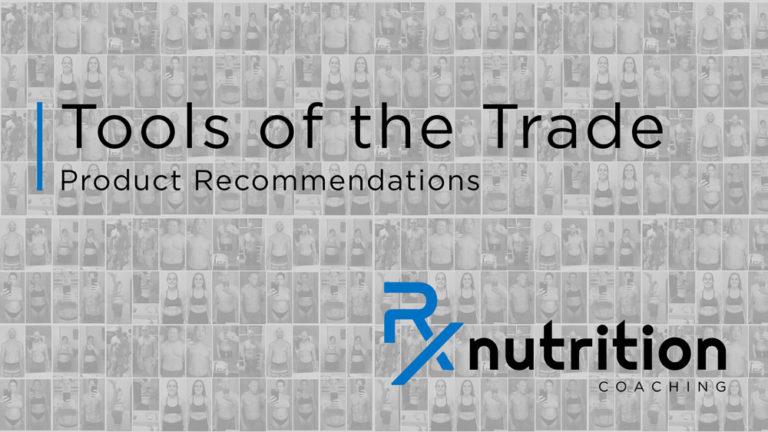Let’s just cut to the chase.
We all have busy lives. Jobs, school, kids, social calendars, and a million other things fighting for our precious time. In fact, that’s probably why we stopped focusing on our nutrition years ago. There’s just not enough time!
And even though we’re working on our nutrition now, there’s a universal truth we can’t escape:
Sometimes we just need a damn drink!
We’re not even going to talk about the negative effects of booze. We all know what they are. We’re also all adults and choose to enjoy the perks that come along with that–you know, on occasion.
So, we’re going to talk about how to build the occasional drink or two into your nutrition program. After all, one of the biggest things we preach is that our approach to eating has to be sustainable. And to be sustainable, it has to be enjoyable. And what the hell is “enjoyable” about a nutrition program where we can’t have a damn drink sometimes?!
Here’s all you need to know.
Calories
The nutrition info for a 12 oz can of Miller Lite says that it has 96 calories, ~3 g of carbohydrates, and 0 g of protein and fat. But wait–that doesn’t add up. We know that caloric value of all the macronutrients:
- Carbohydrates: 4 kcal/g
- Fat: 9 kcal/g
- Protein: 4 kcal/g
And since we remember our 2nd grade multiplication tables, 3 x 4 = 12. So how does a beer with only 3 g of carbs have 96 calories? Because of this:
- Alcohol: 7 kcal/g
Ethyl alcohol is its own “class” of calorie source. It doesn’t fall under carbohydrates (or protein or fat). This is because alcohol has ZERO nutritional value. It provides no macronutrients, micronutrients, vitamins, minerals–nothing. (However, it IS good for bringing introverts out of their shells and making children’s birthday parties bearable–for the adults, of course.)
And that’s why we’re talking about this. So let’s do some more math:
- 96 calories – 12 calories (4 grams of carbs) = 84 calories
So, the other 84 calories in that Lite beer comes from the alcohol. They’re the empty calories that don’t qualify as one of the three macronutrients.
And if we want to enjoy a drink, then we should do so “responsibly.” Which obviously means planning for it, logging it in MyFitnessPal, and entering it on our tracking log.
Even though we track macronutrients, our ultimate goal for weight loss is to maintain a caloric deficit. But, if we only log the 3 g of carbs–and the carb total is all we look at–then we’re going to ruin our deficit.
We have to account for those extra calories. So, we’ve made this easy for you by creating a few unique food entries in MFP. Use these to log your occasional drinks so they count against your macro goals and help you not go over on calories.
Let’s look at screenshots of the entries from the app, along with breakdowns of how we came up with these macro profiles.
Light Beer
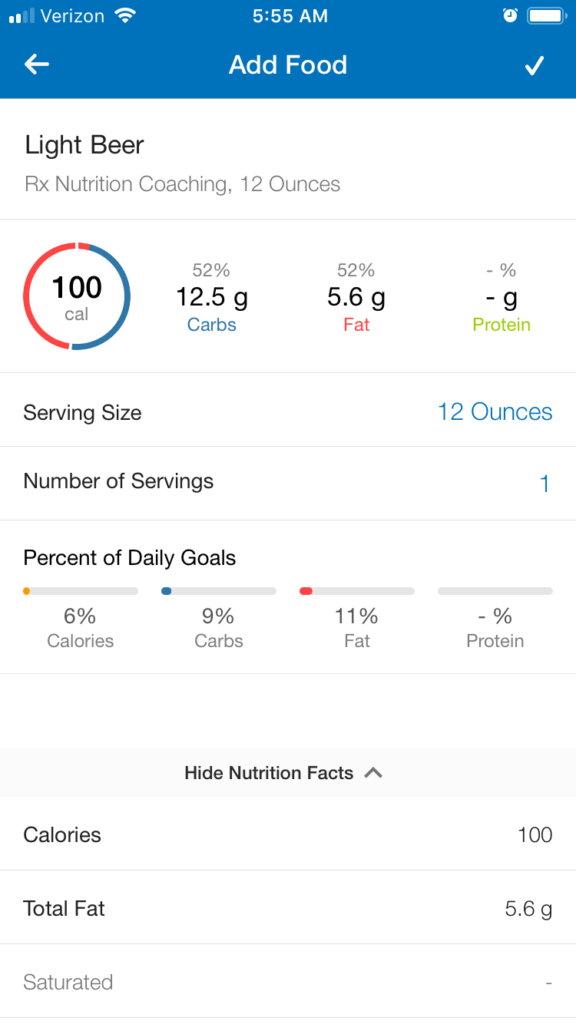
Most light beers are around 100 calories per 12 oz bottle. So we used 5.6 g of fat and 12.5 g of carbs to make up the 100 calories.
Craft Beer, IPAs, Etc.
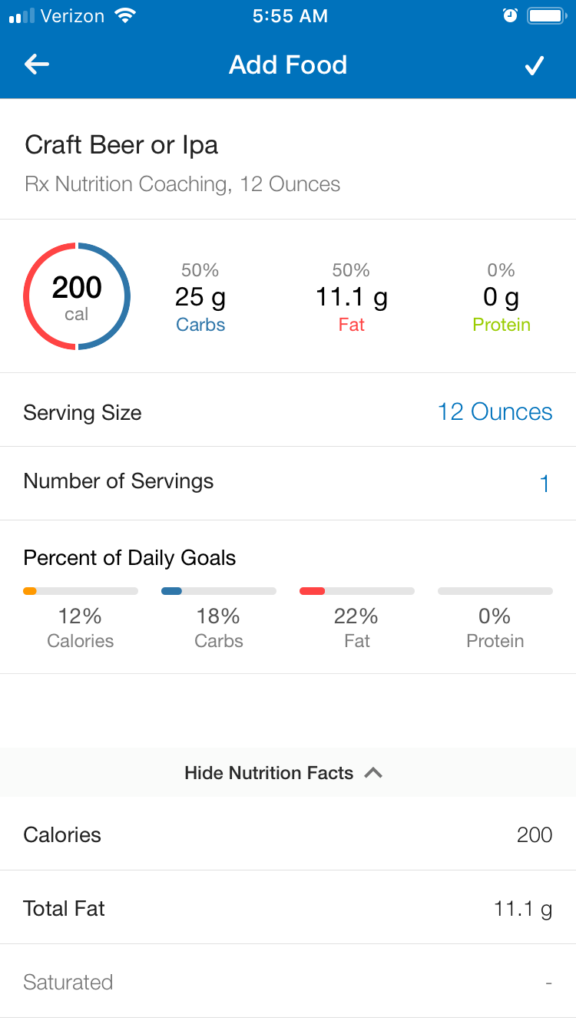
Craft beers, IPAs–you know, the ones that actually taste good–average around 200 calories per 12 oz bottle. So, we used 11.1 g of fat and 25 g of carbs to account for that.
Wine
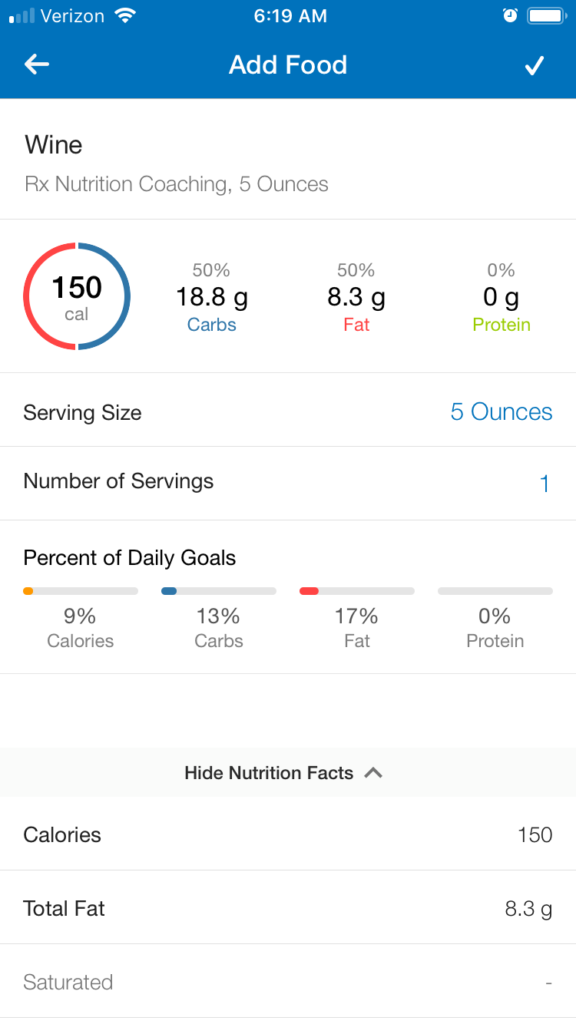
Wines are all over the place because they’re all so different. But, they seem to all be in the 150 calorie range per 5 oz serving (no matter the color or style). Our wine entry logs this as 8.3 g of fat and 18.8 g of carbs.
The Hard Stuff–Straight Liquor
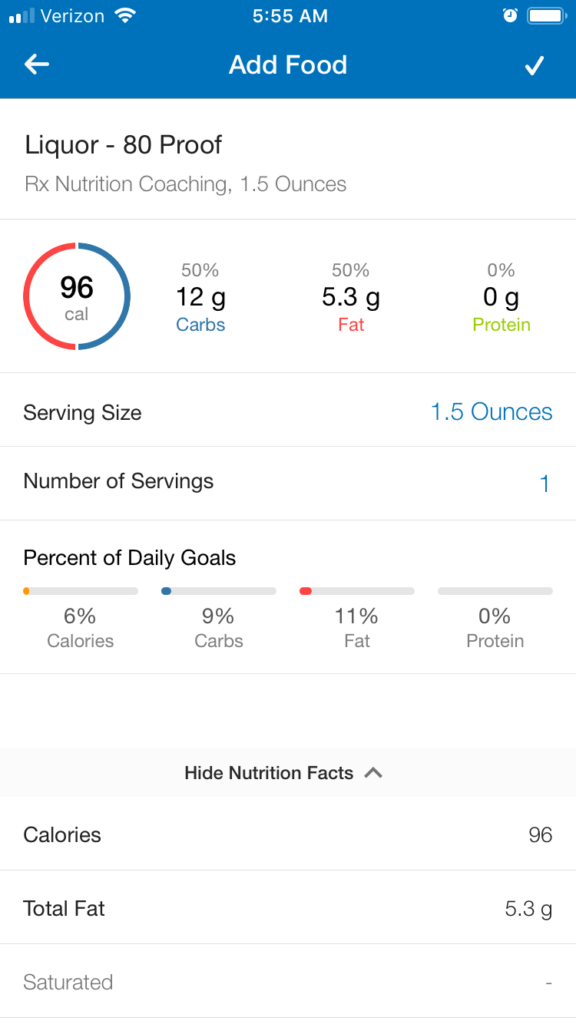
And finally, a shot of liquor is usually around 96 calories. It’s macros are pretty similar to light beer–5.3 g of fat and 12 g of carbs. But notice this for a 1.5 oz serving. If you’re in a place that free-pours (which should be mandatory, by the way), then be careful. And it also does NOT include any other mixers. It’s for the liquor only, so you have to add mixers in separately.
Why We Include Fat in the Macros
Before you ask: no–there isn’t any fat in alcohol. Accounting for more carbs makes sense, but you may be wondering why we assigned some extra calories to fat. Here’s why:
- You need carbs. If we assign ALL the extra calories from the alcohol to carbs, then you may not eat enough of them. We don’t want to take them all away!
- You need protein. It’s important for maintaining lean body mass during a caloric deficit. We’d rather you get as many calories as possible from lean sources of protein.
- You also need fat, but that’s the only macro left 🙂 So, think of it as a “penalty” for drinking adult beverages. Want a drink? Then give us a few of your precious fat grams!
How to Customize the Entries
Our standard MFP alcohol entries will cover your macros and calories within a few percentage points. However, if you want to be precise with your measurements–and God (and Coach) bless you if so–then you’ll want to modify the entries a little to match what you drink.
Let’s get nerdy one more time, step-by-step:
- Find out how many calories are in your drink. Just Google “calories in ___.” For this example, let’s use Fat Tire Amber Ale: 155 calories.
- We’ll use the “Rx Nutrition Light Beer” entry for this. With the calculator, we need to convert the 100-calorie entry to 155 calories. Using the calculator on your phone, enter 155 kcal x 12 oz = 1,860 kcal*oz. Then 1,860 kcal*oz / 100 kcal = 18.6 oz. So, 18.6 oz of the “light beer” entry equals one actual 12 oz bottle of Fat Tire.
- On the MFP entry, change the “Serving Size” to “1 Ounce.”
- Then, change the “Number of Servings” to 18.6.
And voila! One bottle of 155-calorie beer:
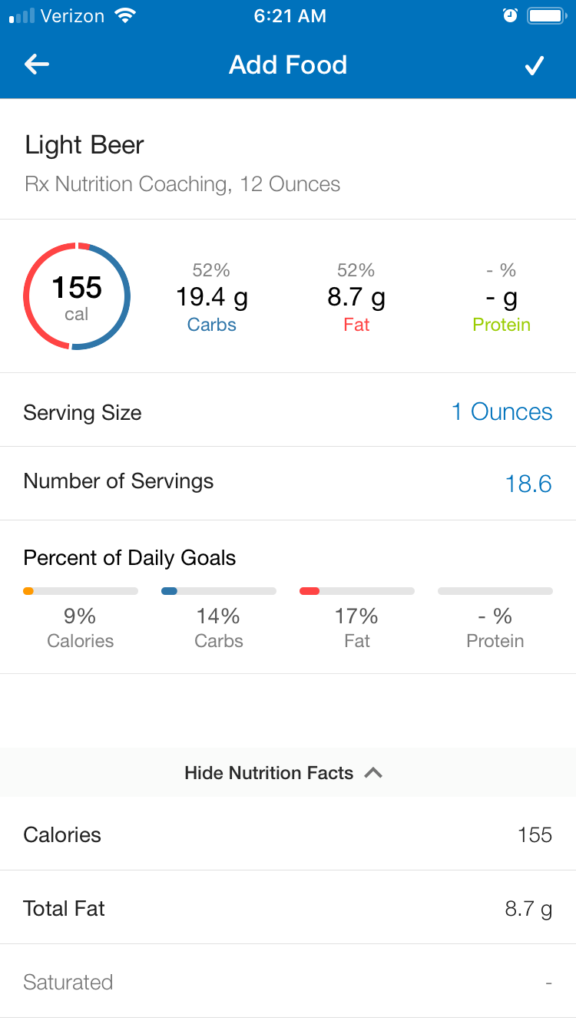
If that’s too complicated, just set your “Serving Size” to 1 oz and start changing the “Number of Servings” until the calories hit the number you want. 🙂
And there you have it. That’s the simplest way we can explain how to build the occasional drink into your nutrition plan.
Notice we said, “occasional.”
Cheers!

